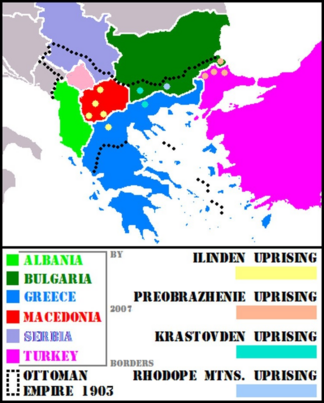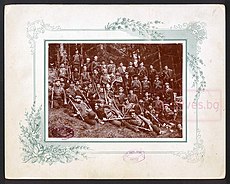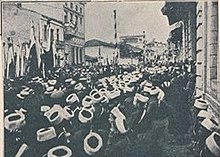Ilinden–Preobrazhenie Uprising
| Ilinden–Preobrazhenie Uprising | |||||||
|---|---|---|---|---|---|---|---|
| Part of the Macedonian Struggle | |||||||
 Map of the uprising in the regions of Macedonia and Thrace, with contemporary Ottoman frontiers and present-day borders | |||||||
| |||||||
| Belligerents | |||||||
|
|
| ||||||
| Commanders and leaders | |||||||
| |||||||
| Strength | |||||||
| 26,408 (IMARO figures)[1] | 350,931[1] | ||||||
| Casualties and losses | |||||||
IMARO figures:[1]
| 5,328 killed / wounded[1] | ||||||
The Ilinden–Preobrazhenie Uprising, or simply the Ilinden Uprising of August–October 1903 (
The rebellion in the region of
By the time the rebellion had started, many of its most promising potential leaders, including Ivan Garvanov and Gotse Delchev, had already been arrested or killed by the Ottomans. The rebellion was supported by armed detachments which had infiltrated its area from the territory of the Principality of Bulgaria. When the rising began there were attempts to force the Bulgarian government to send the army against the Ottomans. The rebels appealed to Sofia for help too, but the government was pressured by the Great Powers to refrain from military intervention.[17] The revolutionaries managed to maintain a guerrilla campaign against the Turks for the next few months, but the rising was crushed. This was followed by a mass wave of refugees from the areas of Macedonia and Southern Thrace, mostly to Bulgaria, but also to the US and Canada. Its greater effect was that it persuaded the European powers to attempt to convince the Ottoman sultan that he must take a more conciliatory attitude toward his Christian subjects in Europe.[18] Through bilateral agreement, signed in 1904, Bulgaria committed not to support the revolutionary movement, while the Ottomans undertook to implement the Mürzsteg Reforms, however neither happened.
The uprising is celebrated today in both Bulgaria and North Macedonia as the peak of their nations’ struggle against the Ottoman rule and thus it is still a divisive issue. While in Bulgaria it is considered as a general rebellion prepared by the joint revolutionary organization of the
Prelude
This section needs additional citations for verification. (July 2020) |
At the turn of the 20th century, the Ottoman Empire was crumbling, and the lands they had held in Eastern Europe for over 500 years were passing to new rulers. Macedonia and Thrace were regions of indefinite boundaries, adjacent to the recently independent Greek, Bulgarian and Serbian states, but themselves still under the control of the Ottoman Turks. Each of the neighbouring states based claims to Macedonia and Thrace on various historical and demographic grounds. The population, however, was highly mixed, and the competing historical claims were based on various empires in the distant past.[29][page needed] The competition for control took place largely via of propaganda campaigns, aimed at winning over the local population, and conducted largely through churches and schools. Various groups of mercenaries were also supported by the local population and the three competing governments.[29][page needed][30][page needed]

The most effective group was the
Since the term
The two groups had different strategies. IMARO as originally conceived sought to prepare a carefully planned uprising in the future, but the Supremacists preferred immediate raids and guerilla operations to foster disorder and a precipitate interventions.
Meanwhile, in late April 1903, a group of young anarchists from the Gemidzhii Circle - graduates from the

By these circumstances the Supremacists' plan went ahead. Under a leadership from
During the discussions, Racho Petrov's Bulgarian government supported IMARO's position that the rebellion was entirely internal. As well as Petrov's personal warning to Gotse Delchev in January 1903 to delay or even cancel the rebellion, the government sent out a circular note to its diplomatic representatives in Thessaloniki, Bitola and Edirne, advising the population not to succumb to pro-rebellion propaganda, as Bulgaria was not ready to support it.[36]
Old Russian Berdan and Krnka rifles as well as Mannlichers were supplied from Bulgaria to Skopje following the demand for higher rates of fire by Bulgarian army officer Boris Sarafov.[37] In his memoir, Sarafov states that the main source of funds for the purchase of the weapons from the Bulgarian army came from the kidnapping of Miss Stone as well as from contacts in Europe.[38]
Ilinden Uprising
| History of Bulgaria |
|---|
 |
|
|
|
Main category |
| History of North Macedonia |
||
|---|---|---|
 | ||
| Chronological | ||
|
||
| Topical | ||
| Related | ||
| Lists and outlines | ||
|
Свобода или смърть .An account of the dates and details of the uprising were recorded by the anarchist author Georgi Khadzhiev which was translated by Will Firth. On 28 July, the message was sent out to the revolutionary movements, though the secret was kept until the last moment. The uprising began on the night of August 2, and involved large regions in and around Bitola, around the south-west of what is now North Macedonia and some of the north of Greece. That night and early the next morning, the town of Kruševo was attacked and captured by 800 rebels. Concurrently, after three days of fighting followed by a siege starting on August 5, the town of Smilevo was captured by the rebels. The town of Kleisoura, near Kastoria, was taken by insurgents about August 5. On August 14, under the leadership of Nikola Pushkarov, some bands near Skopje attacked and derailed a military train. In Razlog the population joined in the uprising. This was further east, in Pirin Macedonia in present-day Bulgaria.[14] On August 4, under leadership of Nikola Karev, a local administration called Kruševo republic had been set up. That same day and the next, Turkish troops made unsuccessful attempts to retake Kruševo.[14] On August 12, following the Battle of Sliva, a force of 3,500 Ottoman soldiers[41] recaptured and burned Kruševo. It had been held by the insurgents for just ten days. Kleisoura was finally recaptured by the Ottomans on August 27.[14] Other regions involved included Ohrid, Florina, and Kičevo. In the Thessaloniki region, operations were much more limited and without much local involvement, due in part to disagreements between the factions of the Internal Macedonian Revolutionary Organization (IMRO). There was also no uprising in the Prilep area, immediately to the east of Bitola.[14] The reason why the uprising was strategically chosen in the Bitola vilayet, and the broader southwestern region of Great Powers that the uprising was purely of a Macedonian character and phenomenon.[42] Per one of the founders of IMARO — Petar Poparsov the idea to keep distance from Bulgaria, was because any suspicion of its interference could harm both sides: Bulgaria and the organisation.[43] In fact the uprising soon spread to the adjacent vilayets of Kosovo, Thessaloniki and Adrianople (in Thrace).[44]
Krastovden Uprising
In areas encompassing the uprising of 1903, Albanian villagers were in a situation of being either under threat from IMRO četas or recruited by Ottoman authorities to end the uprising.[45] Preobrazhenie Uprising According to Khadzhiev, the main goal of the uprising in Thrace was to give support to the uprisings further west, by engaging Turkish troops and preventing them from moving into Macedonia. Many of the operations were diversionary, though several villages were taken, and a region in Strandzha was held for around twenty days. This is sometimes called the Strandzha Republic or Strandzha Commune, but according to Khadzhiev "there was never a question of state power in the Thrace region."[14]
Rhodope Mountains UprisingIn the Dedeagach.[46]
Aftermath The reaction of the Ottoman Turks to the uprisings was one of overwhelming force. The only hope for the insurgents was outside intervention, and that was never politically feasible. Indeed, although Bulgarian interests were favoured by the actions, the Bulgarian government itself had been required to outlaw the Macedonian rebel groups prior to the uprisings and sought the arrest of its leaders. This was a condition of diplomacy with Russia.[34][page needed] The waning Ottoman Empire dealt with the instability by taking vengeance on local populations that had supported the rebels. Casualties during the military campaigns themselves were comparatively small, but afterward, thousands were killed, executed or made homeless. Historian Barbara Jelavich estimates that about nine thousand homes were destroyed,[30][page needed] and thousands of refugees were produced. According to Georgi Khadzhiev, 201 villages and 12,400 houses were burned, 4,694 people killed, with some 30,000 refugees fleeing to Bulgaria.[14] On September 29, the General staff of the Uprising sent the Letter N 534 to the Bulgarian government , appealing for immediate armed intervention:
Still, Bulgaria was unable to send troops to the rescue of the rebelling fellow Bulgarians in Macedonia and Adrianople, Thrace. When IMARO representatives met the Bulgarian Prime-Minister Racho Petrov, he showed them the ultimatums by Serbia, Greece and Romania, which he had just received and which informed him of those countries' support for Turkey, in case Bulgaria intervened to support the rebels.[48] At a meeting in early October, the general staff of the rebel forces decided to cease all revolutionary activities, and declared the forces, excepting regular militias, to be disbanded.[14] After the uprising, IMARO became more strongly associated with the Supremacists, and with the goal of hegemony by Bulgaria.[34][page needed] The savagery of the insurrections and the reprisals did finally provoke a reaction from the outside world. In October, Nicholas II of Russia met at Mürzsteg and sponsored the Mürzsteg program of reforms, which provided for foreign policing of the Macedonia region, financial compensation for victims, and establishment of ethnic boundaries in the region.[31][page needed] The reforms achieved little practical result apart from giving more visibility to the crisis. The question of competing aspirations of Greece, Serbia, Bulgaria, and local advocates for political autonomy were not addressed, and the notion of ethnic boundaries was impossible to implement effectively. In any case, these concerns were soon overshadowed by the Young Turk revolution of 1908 and the subsequent dissolution of the Ottoman Empire.
Subsequent history Greco-Turkish War. Most of the local Bulgarian political and cultural figures were persecuted or expelled from Serbian and Greek parts of Macedonia and Thrace, where all structures of the Bulgarian Exarchate were abolished. Thousands of Macedonian Slavs left for Bulgaria. Some fled after the Greeks burned Kilkis, during the Second Balkan War, and the Treaty of Neuilly population exchange between Greece and Bulgaria saw 92,000 Bulgarians exchanged with 46,000 Greeks from Bulgaria.[51] Bulgarian (including the Macedonian dialects) was prohibited, and its surreptitious use, whenever detected, was ridiculed or punished.[52]
The Internal Macedonian Revolutionary Organisation and continued its struggle against Serbian and Greek authorities until 1934.[citation needed ]
IMRO had de facto full control of Bulgarian Pirin Macedonia (the Petrich District of the time) and acted as a "state within a state", which it used as a base for hit and run attacks against Yugoslavia and Greece. IMRO began sending armed bands called cheti into Greek and Yugoslav Macedonia to assassinate officials and stir up the spirit of the oppressed population.[citation needed] At the end of 1922, the Greek government started to expel large numbers of Bulgarians from coup of 19 May 1934 to take control and break the power of the organizations.[citation needed ]
Legacy   
Portrayals of the insurrections by later historians often reflect ongoing national aspirations. Historians from North Macedonia see them as a part of the move for an independent state as finally achieved by their own new nation. There is, in fact, very little historical continuity from the insurrections to the modern state, but Macedonian sources tend to emphasize the early goals of political autonomy when IMARO was established. The Supremacist faction pushed for the insurrections to take place in the summer of 1903, while the left wing argued for more time and more planning.[54] Historians from Bulgaria emphasize the undoubted Bulgarian character of the rebels, but tends to downplay the moves for political autonomy that were a part of the IMARO organization prior to the insurrections.[citation needed] Western historians generally refer simply to the Ilinden uprising, which marks the date on which uprising began. In Bulgaria it is more common to refer to the Ilinden-Preobrazhenie uprising, giving equal status to the activities commenced at Preobrazhenie near to the Bulgarian coast of the Black Sea and limiting an undue focus on the Macedonian region. Some sources recognize these as two related but distinct insurrections, and name them the Ilinden uprising and the Preobrazhenie uprising. Bulgarian sources tend to emphasize the moves within IMARO for hegemony with Bulgaria, as advocated by the Supremacist and the right wing factions.[citation needed] The Ilinden–Preobrazhenie Uprising was celebrated by the Macedonian and Thracian diaspora in Bulgaria and by all factions within the IMARO. It was commemorated officially in Macedonia under ASNOM as a constituent republic of the Socialist Federal Republic of Yugoslavia. The ASNOM event is now referred as the 'Second Ilinden' in North Macedonia, though there is no direct link to the events of 1903. In Bulgaria Ilinden and Preobrazhenie days as anniversaries of the uprising are publicly celebrated on a local level, primarily in the Pirin Macedonia and Northern Thrace regions.[citation needed ]
ControversyThere have been long-going disputes between parties in Bulgaria and North Macedonia about the ethnic affiliation of the insurgents. The opinion of most Macedonian historians and politicians is that Preobrazhenie uprising was a Bulgarian uprising, not related with the Ilinden one, which was organized by Bulgarian national identity.[63]
The dominant view in Bulgaria is that at that time the Macedonian and Thracian Bulgarians predominated in all regions of the uprisings and that Macedonian ethnicity did still not exist.[64] More, the first name of the IMRO was "Bulgarian Macedonian-Adrianople Revolutionary Committees". Initially its membership was restricted only for Bulgarians. It was active not only in Macedonia but also in Thrace. Since its early name emphasized the Bulgarian nature of the organization by linking the inhabitants of Thrace and Macedonia to Bulgaria, these facts are still difficult to be explained from the Macedonian historiography. They suggest that IMRO revolutionaries in the Ottoman period did not differentiate between 'Macedonians' and 'Bulgarians'. Moreover, as their own writings attest, they often saw themselves and their compatriots as 'Bulgarians' and wrote in Bulgarian standard language.[65] It has also to be noted that some attempts from Bulgarian officials for joint actions and celebration of the Ilinden uprising were rejected from Macedonian side as unacceptable.[66][67] Nevertheless, on August 2, 2017, the Bulgarian Prime Minister Boyko Borisov and his Macedonian colleague Zoran Zaev placed wreaths at the grave of Gotse Delchev on the occasion of the 114th anniversary of the Ilinden–Preobrazhenie Uprising, after the previous day, both have signed a treaty for friendship and cooperation between the neighboring states.[68] The treaty also calls for a committee to "objectively re-examine the common history" of Bulgaria and Macedonia and envisages both countries will celebrate together events from their shared history.[69] According to Bulgarian officials, this commission has made little progress in its work for a period of two years.[70] Moreover in an interview on August 4, 2018 Zaev said that “the Ilinden uprising is Macedonian” and “if any citizen of Bulgaria wants to celebrate it, let them celebrate it.”[71] As result in 2020, Bulgaria blocked the candidature of North Macedonia to the European Union over an 'ongoing nation-building process' based on historical negationism of the Bulgarian legacy in the broader region of Macedonia.[72][73][74] HonourIn Bulgaria
In North Macedonia
Elsewhere
See alsoWikimedia Commons has media related to Ilinden-Preobrazhenie Uprising.
Footnotes
Notes
Sources
|
